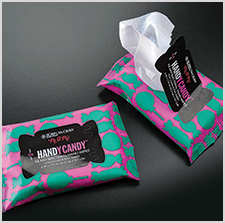4 Key Factors Keeping Flexible Packaging Growth on the Rise
June 19, 2018
Inland Packaging has been immersed in the world of flexible packaging since the early 2000’s and we’ve since seen flexible packaging expand into more diverse markets with more complex structures. As flexible packaging becomes more prominent in the marketplace, brands excel in their branding efforts and step outside the norm as new products come to fruition.
Flexible Packaging Association conducted a poll and reported, “83 percent of all brand owners are currently using flexible packaging of some type. In addition, 26 percent of all brands have increased their usage of flexible packaging in the past five years, and 31 percent intend to increase their flexible packaging used in the next five years.” These are stats we like to see and what gets us excited for what’s to come in the industry.
There are four key factors playing a huge role in the consistent growth of flexible packaging in the food, beverage and consumer products industries.
- Functionality
- Innovation
- Convenience
- Sustainability
Functionality
Flexible packaging comes in all shapes and sizes. Packaging types vary from flat pouches, sachets, stand-up pouches, stick packs, to bar wraps and beyond. Each format has different requirements for the most efficient and appropriate construction. One of the most important questions we ask is “what the active ingredients are in your products that may require unique materials for success on the shelf?”. A perfect example are bar wraps which may require a specific construction based on the main ingredient, i.e. peanut butter, which might go into a snack bar. The oils in peanut butter require a specific construction to contain the oils so the greasy residue does not leak through the packaging into the graphics. It’s important to understand the goals and expectations for each product so that the correct materials can be selected. In the food industry, the use of barrier films can be critical for particular end-use products. Barrier films avert the permeation of moisture or oxygen within the packaging to preserve product’s flavor and freshness on the shelf.
Versatility and functionality go beyond material selection. Packaging can have various finishes such as gloss, matte, soft touch or a combination of gloss and matte. Each of these finishes provides a distinguishing look and feel to the consumer as well as giving your brand its own recognition. I bet a majority of you have noticed the matte finish, often times found in natural food products, gaining a presence on products in stores. This finish has started to give packaging an existence that stands out against some of the glossy packaging that we have traditionally seen lining the shelves. Each brand and product calls for its own unique finish, when matte may work for some, a high gloss may work for others, but know there are options out there.
The means in which a flexible packaging opens and closes is a critical component to the integrity as well as impacts the consumers experience with your brand. Some of the most common closures include laser scoring, tear notches, spout fitments or zippers. Each of these provides an element of functionality to the package. Whether used individually or combined, depending on what is chosen to get your flexible package opened and closed can make or break the success of the product. The way in which consumers interact with your package has a direct impact on your brand and shelf appeal, but functionality can be what pushes someone to provide a positive – or a negative – review.
Innovation
We’ve said it once, and we’ll say it again. Customization. This is where your creative minds can go to work and true innovation happens. Promotional, seasonal, highly targeted and test market packaging are finally efficient to produce. With our variable data and graphics utilizing our digital technology, every single piece can be unique. Serialization? Security features? Name it. It can be done.
We often get asked, “What’s the coolest flexible packaging piece you’ve seen?” Although there are too many to choose from, we’d quickly toss you this package. It may look like a facial wipes packaging for traveling, but there is more than meets the eye. Our partner, Exothermix has introduced a game-changing technology that essentially creates a self-heating package. When a consumer peels away a secondary label that is on the outside of the package, it exposes the heating (or cooling) element below to the air which activates it. The pouch then begins to heat up the facial wipe inside for a pleasing user experience. This technology is now being used in the health and beauty as well as medical markets.
Convenience
Quick. Easy. Simple. To-go. If you ask me, I will take “all of the above” when it comes to the products I am grabbing off the shelf… and you can probably agree that I’m not the only one. Consumers are consistently looking for convenience in both the packaging and the handling of their products. Consumers truly want to be able to throw a package into their bag and run to their next appointment or kids’ baseball game. Who wants to put snacks into a separate baggie? Or who wants to lug around an entire box of crackers in our purse or backpack? No way! Instead, we can grab a flexible pouch with a resealable zipper for many of the snacks we love. Now let’s take convenience one step further – single-serve packaging. According to Packaging Digest, it was discussed at the Sweets and Snacks Expo, “snacking tends to be a solitary experience – the average American snacks 2.5 times a day, and younger generations snack even more.” This proves that offering single-serve packaging is a perfect way to set your product up for success!
Sustainability
Consumers’ desire for convenience shares a comparable level of importance as the desire for sustainability in packaging. Sustainability initiatives are being declared by many brand owners in the marketplace. We attended the NPE show last month and were surrounded by discussions regarding thin wall alternatives and sustainability. For quite some time the packaging industry has been pushed to create thinner plastics across many packaging types and decoration methods, whether it be containers, bottles, bottle caps and even labels. This type of mindset is not any different in the flexible packaging world. Many collaborative efforts and advocacy programs are being discussed and major players in the industry are tackling a variety of end-of-life sustainability measures for flexible packaging, including decomposition rates, recyclability rates, and material reduction and composition.
When compared to traditional packaging formats, flexible packaging has helped with the reduction of food waste, carbon footprint, and shipping damages. The Flexible Packaging Association displayed the perfect infographic that shows transporting one truckload of unfilled flexible pouches is equivalent to transporting 26 truckloads of unfilled glass jars for the same amount of product. Your carbon footprint can be drastically impacted by a move to a lighter, more sustainable package.
We must say, it is fun and very exciting to be a player in the flexible packaging world. The products coming off our presses truly bring the best in functionality, convenience, innovation, and sustainability. Let’s add your product to our wall of fame! Don’t hesitate to reach out if you are interested in talking about an upcoming project!



